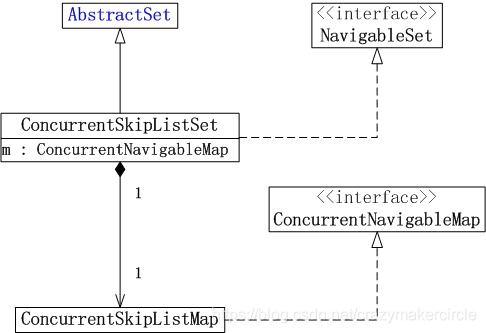多线程篇(其它容器- ConcurrentSkipListSet)(持续更新迭代)
目录
一、简介
二、原理
1. 类继承图
2. 内部结构
3. 构造器
4. 核心方法
三、适用场景
四、ConcurrentSkipListSet和TreeSet对比
五、应用案例
一、简介
ConcurrentSkipListSet,是JUC新增的一个集合工具类,顾名思义,它是一种SET类型。
SET类型,在数学上称为“集合”,具有互异性、无序性的特点,也就是说SET中的任意两个元素均不相同(即不
包含重复元素),且元素是无序的。
JDK提供的默认SET实现——HashSet,其实就是采用“组合”的方式——内部引用了一个HashMap对象,以此
实现SET的功能。
ConcurrentSkipListSet与ConcurrentSkipListMap的关系,与SET与HashMap的关系类似,就是采用“组合”
的方式:ConcurrentSkipListSet组合了一个ConcurrentSkipListMap,将元素作为 ConcurrentSkipListMap的
key存放。
二、原理
1. 类继承图
我们来看下ConcurrentSkipListSet的类继承图:

2. 内部结构
ConcurrentSkipListSet的数据结构,如下图所示:

说明:
(01) ConcurrentSkipListSet继承于AbstractSet。因此,它本质上是一个集合。
(02) ConcurrentSkipListSet实现了NavigableSet接口。因此,ConcurrentSkipListSet是一个有序的集合。
(03) ConcurrentSkipListSet是通过组合ConcurrentSkipListMap实现的。它包含一个
ConcurrentNavigableMap对象m,而m对象实际上是ConcurrentNavigableMap的实现类
ConcurrentSkipListMap的实例。ConcurrentSkipListMap中的元素是key-value键值对;
而ConcurrentSkipListSet是集合,它只用到了ConcurrentSkipListMap中的key!
3. 构造器
ConcurrentSkipListSet的实现非常简单,其内部引用了一个ConcurrentSkipListMap对象,
所有API方法均委托ConcurrentSkipListMap对象完成:
public class ConcurrentSkipListSet<E> extends AbstractSet<E>implements NavigableSet<E>, Cloneable, java.io.Serializable {/*** The underlying map. Uses Boolean.TRUE as value for each* element. This field is declared final for the sake of thread* safety, which entails some ugliness in clone().*/private final ConcurrentNavigableMap<E, Object> m;public ConcurrentSkipListSet() {m = new ConcurrentSkipListMap<E, Object>();}public ConcurrentSkipListSet(Comparator<? super E> comparator) {m = new ConcurrentSkipListMap<E, Object>(comparator);}public ConcurrentSkipListSet(Collection<? extends E> c) {m = new ConcurrentSkipListMap<E, Object>();addAll(c);}public ConcurrentSkipListSet(SortedSet<E> s) {m = new ConcurrentSkipListMap<E, Object>(s.comparator());addAll(s);}ConcurrentSkipListSet(ConcurrentNavigableMap<E, Object> m) {this.m = m;}// ...
}从上述代码可以看出,ConcurrentSkipListSet在构造时创建了一个ConcurrentSkipListMap对象,并由字段m
引用,所以其实ConcurrentSkipListSet就是一种跳表类型的数据结构,其平均增删改查的时间复杂度均为
O(logn)。
4. 核心方法
我们来看下ConcurrentSkipListSet是如何实现API方法的:
public int size() {return m.size();
}public boolean isEmpty() {return m.isEmpty();
}public boolean contains(Object o) {return m.containsKey(o);
}public boolean add(E e) {return m.putIfAbsent(e, Boolean.TRUE) == null;
}public boolean remove(Object o) {return m.remove(o, Boolean.TRUE);
}public void clear() {m.clear();
}//...从上述代码可以看出,所有操作均是委托ConcurrentSkipListMap对象完成的。重点看下add方法:
public boolean add(E e) {return m.putIfAbsent(e, Boolean.TRUE) == null;
}ConcurrentSkipListMap对键值对的要求是均不能为null,所以ConcurrentSkipListSet在插入元素的时候,用
一个Boolean.TRUE对象(相当于一个值为true的Boolean型对象)作为value,同时putIfAbsent可以保证不会
存在相同的Key。所以,最终跳表中的所有Node结点的Key均不会相同,且值都是Boolean.True。
三、适用场景
ConcurrentSkipListSet是线程安全的有序的集合,适用于高并发的场景。
四、ConcurrentSkipListSet和TreeSet对比
ConcurrentSkipListSet和TreeSet,它们虽然都是有序的集合。
但是,第一,它们的线程安全机制不同,TreeSet是非线程安全的,而ConcurrentSkipListSet是线程安全的。
第二,ConcurrentSkipListSet是通过ConcurrentSkipListMap实现的,而TreeSet是通过TreeMap实现的。
五、应用案例
import java.util.*;
import java.util.concurrent.*;/** ConcurrentSkipListSet是“线程安全”的集合,而TreeSet是非线程安全的。** 下面是“多个线程同时操作并且遍历集合set”的示例* (01) 当set是ConcurrentSkipListSet对象时,程序能正常运行。* (02) 当set是TreeSet对象时,程序会产生ConcurrentModificationException异常。** @author skywang*/
public class ConcurrentSkipListSetDemo1 {// TODO: set是TreeSet对象时,程序会出错。//private static Set<String> set = new TreeSet<String>();private static Set<String> set = new ConcurrentSkipListSet<String>();public static void main(String[] args) {// 同时启动两个线程对set进行操作!new MyThread("a").start();new MyThread("b").start();}private static void printAll() {String value = null;Iterator iter = set.iterator();while(iter.hasNext()) {value = (String)iter.next();System.out.print(value+", ");}System.out.println();}private static class MyThread extends Thread {MyThread(String name) {super(name);}@Overridepublic void run() {int i = 0;while (i++ < 10) {// “线程名” + "序号"String val = Thread.currentThread().getName() + (i%6);set.add(val);// 通过“Iterator”遍历set。printAll();}}}
}运行程序,结果如下:
a1, b1,
a1, a1, a2, b1,
b1, a1, a2, a3, b1,a1, a2, a3, a1, a4, b1, b2,
a2, a1, a2, a3, a4, a5, b1, b2,
a3, a0, a4, a5, a1, b1, a2, b2,
a3, a0, a4, a1, a5, a2, b1, a3, b2, a4, b3,
a5, a0, b1, a1, b2, a2, b3,
a3, a0, a4, a1, a5, a2, b1, a3, b2, a4, b3, a5, b4,
b1, a0, b2, a1, b3, a2, b4,
a3, a0, a4, a1, a5, a2, b1, a3, b2, a4, b3, a5, b4, b1, b5,
b2, a0, a1, a2, a3, a4, a5, b3, b1, b4, b2, b5,
b3, a0, b4, a1, b5,
a2, a0, a3, a1, a4, a2, a5, a3, b0, a4, b1, a5, b2, b0, b3, b1, b4, b2, b5, b3,
b4, a0, b5,
a1, a2, a3, a4, a5, b0, b1, b2, b3, b4, b5,
a0, a1, a2, a3, a4, a5, b0, b1, b2, b3, b4, b5,
a0, a1, a2, a3, a4, a5, b0, b1, b2, b3, b4, b5,
a0, a1, a2, a3, a4, a5, b0, b1, b2, b3, b4, b5,